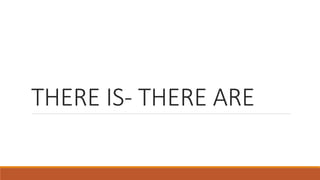
There Is-There Are Quantifiers
- 1. THERE IS- THERE ARE
- 2. USE Las expresiones there is y there are se utilizan en inglés para indicar que un objeto o una persona se encuentran en un sitio especifico. There is a book on the table. “hay un libro sobre la mesa” There are two books on the table. “hay dos libros sobre la mesa”
- 3. THERE IS Utilizamos there is cuando el sujeto es: • Un sustantivo contable singular: There is an apple in the basket. Observa que el sustantivo lleva el artículo idenfinido (a/an). • Un sustantivo incontable: There is some tea in the pot. Un sustantivo incontable son aquellos sustantivos que no se pueden contar, como le arroz, los líquidos, el pan, el hielo.
- 4. THERE ARE Utilizamos there are cuando el sujeto es: • Un sustantivo plural: There are two apples in the basket Recuerda que en inglés los sustantivos irregulares, aunque no lleven la marca “s”, requieren el acuerdo en plural con el verbo to be: There are a lot of children in the street.
- 5. NEGATIVE FORM Las expresiones existenciales there is / there are se construye con la partícula negativa not: There isn’t any apple in the basket. There aren’t twenty children in the class. Para decir que no hay ningún o ninguna se utiliza el cuantificador any.
- 6. INTERROGATIVE Se construye mediante una inversión entre el verbo to be y el sujeto “postizo” there: Is there an apple in the basket? Are there twenty children in the class?
- 7. BIBLIOGRAPHY The information was taken from http://www.ejerciciodeingles.com/cuando-usar-there-is-there-are/
- 8. HOW MUCH . HOW MANY QUESTIONS
- 9. ANTES DE ESTUDIARLO Para poder entender el uso y estructura de estas preguntas, aclararemos las dos clases de sustantivos en inglés: CONTABLES (COUNTABLES )Y NO CONTABLES (UNCOUNTABLES) LOS CONTABLES SON: los sustantivos que se pueden contar A house, two houses, three houses, etc El sustantivo people (gente) es contable ya que el singular es person (persona) One person, two person, three people, four people, etc LOS NO CONTABLES SON: los sustantivos que no se pueden contar Los líquidos, el azúcar, la harina, es decir todos los sustantivos que se pueden contar con una medida (libra (pound) botella (bottle) vatios (watts) segundo(second) etc)
- 10. HOW MANY Se usa para hacer preguntas con los sustantivos contables: How many cups of coffe do you drink? (¿cuántas tazas de café tomas?) How many pants do you have? (¿Cuántos pantalones tienes?) How many apples are there in the fridge? (¿Cuántas manzanas hay en el refrigerador?) El sustantivo está siempre en plural (cups, pants, apples)
- 11. HOW MUCH Se usa con los sustantivos no contables How much coffe do you drink in the morning? (¿Cuánto café tomas en la mañana?) How much wine does France produce? (¿Cuánto café produce Francia?) How much electricity do you consume every month? (¿Cuánta electricidad consumes al mes?) El sustantivo siempre está en singular
- 12. ANSWER FOR HOW MANY Puedes responder con una cantidad precisa: one, two, three, one hundred, million, etc.; de forma relativa: few (pocos), some (algunos), many (muchos), none (ninguno), a lot (muchos), etc. FOR EXAMPLE How many candies do you have in your pocket? (¿Cuántos dulces tienes en tu bolsillo?) Just a few! (¡Solo unos cuantos!) How many suitcases are you going to take in your next trip to Europe? (¿Cuántas maletas vas a llevar en tu próximo viaje a Europa only one. (sólo una.)
- 13. ANSWER FOR HOW MUCH Las respuestas son relativas: some (algo), a lot (mucho), a little (un poco), none (nada), much (mucho), etc. También podemos responder con unidades de medida, peso, volumen, etc. para especificar la cantidad cuando se requiera. How much flour is there in the bowl? (¿Cuánta harina hay en el tazón?) There is some flour in the bowl. (Hay un poco de harina en el tazón.) How much money do you have? (¿Cuánto dinero tienes?) Not too much. (No mucho.) How much time do you need to finish your work? (Cuánto tiempo necesitas para terminar tu trabajo?) Just a few more hours. (Solo unas pocas horas más.)
- 14. How many…? How much…? songs music jobs work bottles wine/milk/water cups coffee/tea chairs furniture suitcases luggage batteries electricity tips advice dollars money views scenery carrots vegetable bananas fruit rings jewelry letters mail pants clothing
- 15. QUANTIFIERS
- 16. USE Quantifiers talk about the amount or the number of a noun. These expressions are mainly “some, any, many, much, a lot of, a little, a few
- 17. SOME and ANY They express an indefinite quantity or number SOME + UNCOUNTABLE NOUNS (affirmative) There is some dust on the floor There is some cheese in the fridge. ANY + UNCOUNTABLE/ COUNTABLE NOUNS (negative and interrogative) There isn’t any milk in the bottle There isn’t any honey at home. Is there any bread on the table?
- 18. MUCH / MANY They express a large quantity AFFIRMATIVE I have many postcards. (COUNTABLE NOUN) She has got much influence on you. (UNCOUNTABLE NOUN) NEGATIVE There isn’t much sugar in the kitchen. (UNCOUNTABLE NOUN) There aren’t many people in the streets. (COUNTABLE NOUN) INTERROGATIVE Has Eric got much cash? (UNCOUNTABLE NOUN) Are there many books in your bag? (COUNTABLE NOUN)
- 19. A FEW / A LITTLE “A few” expresses a small quantity. It expresses a negative idea. I have a few close friends in the city. “A little” expresses a small quantity. It expresses a negative idea. We have a little milk.
- 20. A LOT OF /LOTS OF Expresses a big quantity. There are a lot of bus stops in Bosa. I have got lots of story books.
